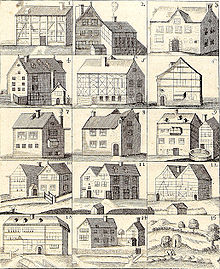François Blondel (medical doctor)
François Blondel ( Germanized Franz Blondel , Latinized Franciscus Blondellus ; * 1613 in Liège ; † May 9, 1703 in Aachen ) was a well-known bath and spa doctor of the 17th century who dealt with the healing effects of thermal springs .
Life
We only know about Blondel's origins that he was born in Liege in 1613 and studied medicine in Douai , where he also received his doctorate in 1643. He initially worked as a doctor in Malmedy and Spa before he was appointed personal physician to Elector Philipp Christoph von Sötern in Trier . After the elector's death in February 1652, he came to Aachen; the city had acquired a certain reputation as a health resort, but was almost completely reduced to rubble by fire in 1656. Blondel stayed anyway and made it his mission - from 1660 as assistant to the bathing inspector Jakob Didier - to make Aachen's mineral springs known.
Above all, he campaigned for the drinking cure that was introduced in Aachen in 1661. The fact that the wife of the Great Elector , Luise Henriette von Oranien , also tried Blondel's drinking cure that year ensured the hoped-for influx. In that year his first medical book about the healing success of the drinking cure was published. From 1666 he was commissioned by the city of Aachen to supervise the local pharmacies. In 1674 Blondel initially took over the duties of the second city doctor ( medicus secundarius ) Nikolaus Klonckart.
After the death of the first city doctor ( medicus primarius ) Mathaeus Geyr in 1686, at the age of 73, the city of Aachen assigned Blondel the task of the first city doctor and fountain and pool inspector.
He died after a long illness on May 9, 1703 and was buried in the church of St. Paul in the Dominican monastery in Aachen .
Blondel's best-known work, which has contributed a lot to Aachen's reputation as a spa, is a detailed explanation and the apparent miracle effect of its holy bathing and drinking waters in Aachen, first published in 1671 in Latin under the title Thermarum Aquisgranensium Et Porcetanarum Descriptio: Congruorum quoque ac salubrium usuum Balneationisuum Potationis Elucidatio . The book has been translated into several languages.
Honors
Since 1977 the city of Aachen has supported Dr. Franciscus Blondel Medal awarded for special merits in the field of rheumatology .
In recognition of the merits, the city of Aachen has named a street near the old spa house after Blondel, which has been equipped with a corresponding additional information sign since 2007 as part of the Aachen thermal water route.
Works
- Ms. Blondelli Thermopotationis Aquisgranensis Enarratio et auspicium ad clar. virum D. Joannem Gaen, med. Leodiensen, Typis P. Ouweni 24 p .; Aachen, 1661
- Lettre de François Blondel Docteur en Medicine au Sieur Jacques Didier Medicin de Sedan, touchant les Eaux Minerales chaudes d'Aix & de Borcet; et au Sieur Jean Gaen, Medicin de Liège, sur le Premices de la Boisson publiquedes mémes Eaux & les rares cures, qui se sont faites par leur usage pendant l'année 1661 , Bruxelles 1662
- Thermarum Aquisgranensium Et Porcetanarum Descriptio: Congruorum quoque ac salubrium usuum Balneationis Et Potationis Elucidatio , Aachen 1671 ( 1st edition ), 1685 (2nd edition), 1688 ( 3rd, revised edition )
- Detailed explanation and apparent miraculous effect of their holy bathing and drinking waters at Aach, in which they have wonderful nature and properties, also varied and proven cures obtained by bathing and drinking, besides necessary and useful instruction, how the healthy so want to sick in their use have behaved, be thoroughly described . Aachen 1688 MDZ-Munich
literature
- Andreas Bernhard: Bad Aachen . In: Rolf Bothe (Ed.): Kurstädte in Deutschland. On the history of a building type . Frölich and Kaufmann, Berlin 1984, ISBN 3-88725-002-8 , pp. 121-184
- Friedrich Haagen : Blondel, Franz . In: Allgemeine Deutsche Biographie (ADB). Volume 2, Duncker & Humblot, Leipzig 1875, p. 721.
- Blondel (Franciscus). In: Johann Heinrich Zedler : Large complete universal lexicon of all sciences and arts . Volume 4, Leipzig 1733, column 185.
- Bernhard Maximilian Lersch : Writings on the thermal baths of Aachen and Burtscheid . Aachen 1867
- Bernhard Maximilian Lersch : History of the bath Aachen . Aachen 1870
- Ingrid Weberbauer: The Aachen spa doctor Franciscus Blondel (1613–1703) and his work . Dissertation RWTH Aachen, Aachen 1977
Web links
Individual evidence
- ↑ See: Erich Keyser, Heinz Stoob: German city book: Handbook of urban history . Kohlhammer, Stuttgart et al. 1939, p. 33.
| personal data | |
|---|---|
| SURNAME | Blondel, François |
| ALTERNATIVE NAMES | Blondel, Franz; Blondel, Franciscus; Blondellus, Franciscus |
| BRIEF DESCRIPTION | Spa and spa doctor |
| DATE OF BIRTH | 1613 |
| PLACE OF BIRTH | Liege |
| DATE OF DEATH | May 9, 1703 |
| Place of death | Aachen |


